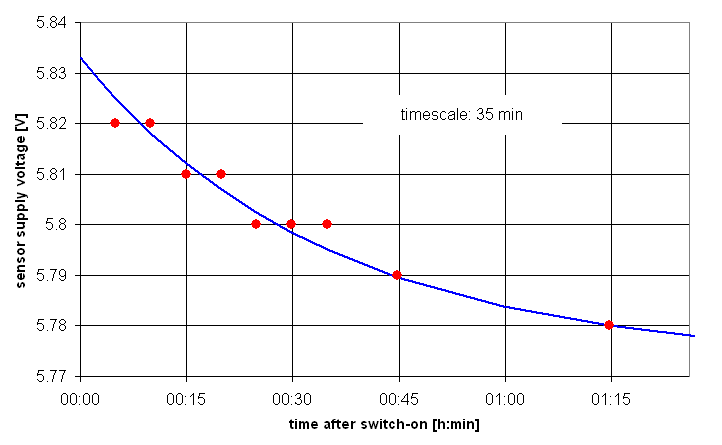
The stability of the positioning system
Joachim Köppen Strasbourg 2008
During the first year of operations we had regularily noticed that the position indicated by the software either changed without our actuating the controls or that just after starting the system the position where we had left the telescope the last time appeared to have changed. Also, we encountered difficulties finding the Sun on the predicted position ...
Finally we observed that the azimuth values show a systematic drift downwards, after the controller is switched on but left alone without making any change of the position. We measured the voltage of the line that supplies a stabilized voltage of about 6 volts to the potentiometers that sense the angles of the rotators. This voltage was found to show a small drift with time after switching on, as shown below

The voltages from the sensing potentiometers changed correspondingly, and so did the azimuth and elevation display in the software. Since the azimuth sensor covers a range of angles of 450°, and the elevation sensor only between 0° and 90° with the same supply voltage, a slight drift of the voltage causes in azimuth a five-times larger drift than in elevation. It is seen that this drift has a settling time-scale of about 35 min.
The reason of this drift is the warming-up of the LM 7806 stabilizer integrated circuit by the current passing through it (about 200 mA) and also from the heat generated from the other electronic components in the controller. A drift of 50 mV would be quite acceptable for a standard application of the controller, which had been designed to deal with antennas that have a beamwidth of more than a few degrees. However, in our system, the hardware is used very close to its design limits!
The controller could be improved by cutting down the thermal drift of the stabilizer IC. This would necessitate a careful analysis of the origin of the drift, and once countermeasures had been taken, such as mounting it on a separate heat sink or placing it in a different compartment, a careful testing of the new system. Another aspect would be to ensure that the new system would also be insensitive to the ambient temperature. All these possible countermeasures would require too much effort and time to be justified by the present use of the telescope!
For normal operations it is therefore recommended to switch on the Yeasu controller some time before observations are to be done. For most applications it would suffice to wait about 30 min, which would avoid most of the initial drift ... normally, the observer will be busy during that time anyway to organize himself ... For some observations, which do rely on stable values of the positions, one should better switch on about 2 hours before any observations in order to spare oneself of irritations and frustration!
In 2009, Zauher Abdullah left the electronics permanently switched on during his spell of two months of solar observations, in order to study whether this would have a beneficial effect. However, we did not notice any substantial improvement of either the positioning system or the stability of the LNB's noise background. So he recommends to keep to the above simple procedure.
Moreover, the Yaesu computer interface gives the positions only in full degrees: This is already quite at the limit, since the antenna HPBW is 1.7° and the Sun has an angular diameter of only 0.5° - thus one can easily miss the Sun, even if positions were precise! It is strongly recommended for e.g. solar scans to search first manually for the true position of the Sun before a full drift scan is attempted, and to use slight offset corrections for the positions.
In the radio amateur literature, it has been demonstrated that the positional accuracy of the Yaesu G-5500 system can be improved, by modification of the position sensing system. However, this requires substantial changes in the hardware and also redesign of the controller software.
Because of the finite accuracy and stability of the positioning systems, one may not rely on that a position is exactly the same, even if the displayed azimuth and elevation values are identical! Thus, it is practical impossible to return to a previously visited position, which prevents any programmed operations, mapping of an area in the sky, and any remote control operations.
| Top of the Page | Back to the MainPage | to my HomePage |
last update: Apr. 2013 J.Köppen